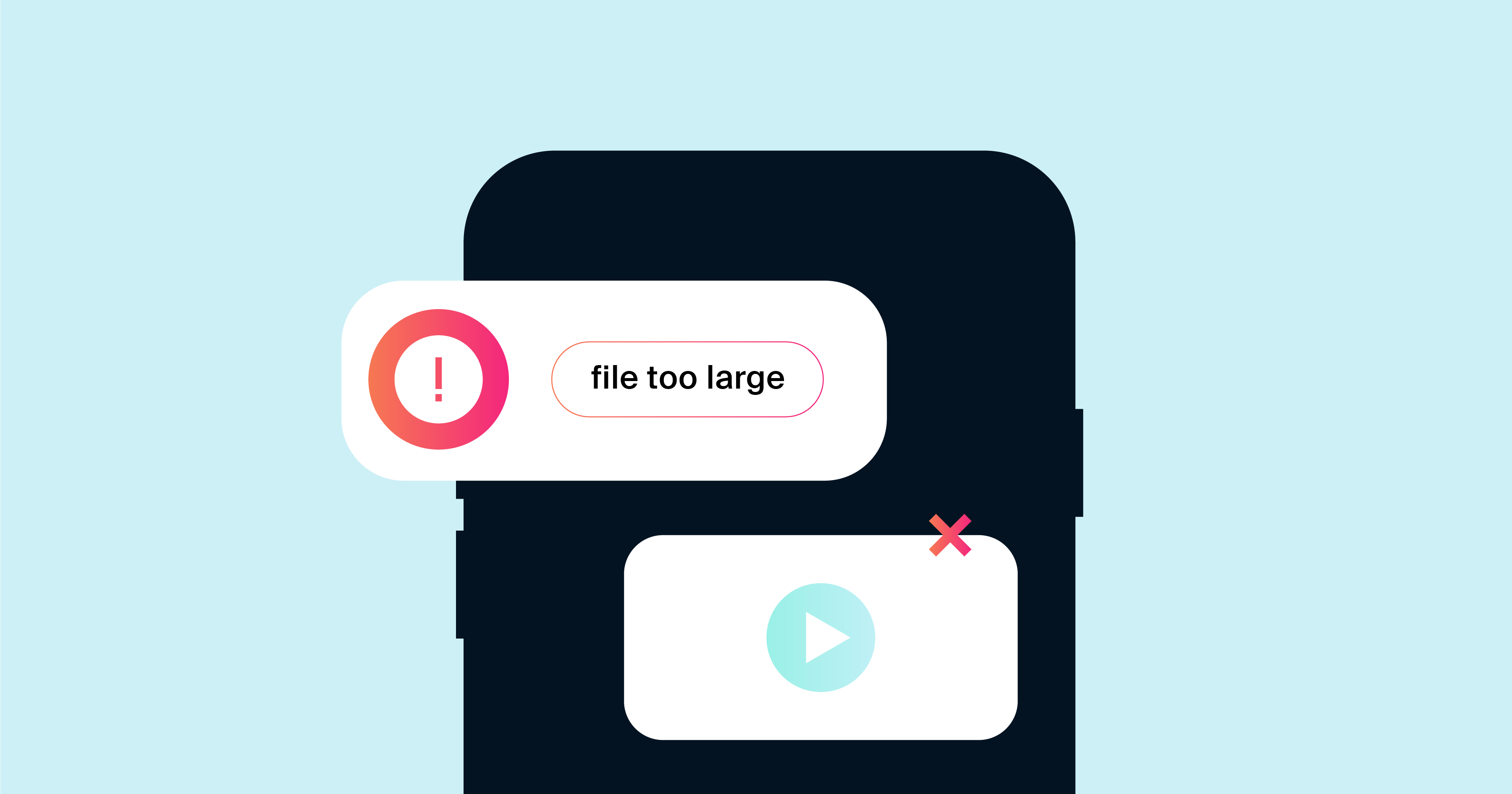How to Send a Video Through Text via MMS, SMS, iOS, and Android
Published: Mar 3, 2023

Videos are an effective way to pass on information in a matter of seconds.
In the business world, you’re either watching one or making one—a product demo, a company announcement, or a customer testimonial.
But what if you want to send videos through text messaging to your customers?
The good news is that, with MMS, you actually can.
After all, if you can text photos and PDF files, sending videos should also be possible.
As great as this sounds, there are limitations to what you can send.
Sending a Single Video via Text
If you want to send one or a couple of videos through text for personal communication, it’s a simple task to do with MMS, iMessage, or Android Messages.
Here are the simple steps for sending a video through text using the three channels mentioned above:
MMS
- Open your messaging app.
- Start a new message or open an existing conversation.
- Tap the attachment icon (usually a paperclip or camera icon
- Tap "Send."
iMessage
- Open the Messages app on your iPhone.
- Start a new message or open an existing conversation.
- Tap the camera icon to open your photo and video library.
- Select the video you want to send.
- Tap the blue arrow to send the video.
Android Messages
- Open the Messages app on your Android device.
- Start a new message or open an existing conversation.
- Tap the attachment icon (usually a paperclip or camera icon).
- Select the video you want to send from your gallery.
- Tap the send button (usually a paper airplane icon).
When you’re sending videos via text, you may also want to account for the file size limits that some carriers have for media attachments.

What to Know When You Want to Send Videos Through Text
1. Video Size Limits
While mobile phones generally have a size restriction for sharing videos via text, the main consideration here is the carriers in the case of MMS.
Size limits vary from one mobile carrier to another and tend to be stricter than those of mobile developers.
But how long can a video be to send through text?
It’s not exactly the length of the video itself that matters, but rather the size of the file.
AT&T, for instance, has a limit of 1 MB for each file, whereas Verizon allows up to 3.5 MB.
Should you need to send videos through text, make sure to check with your mobile carrier about size restrictions.
Size restrictions also have to do with the device you have.
A. Sending videos through text on iPhone
Videos going from iPhone to iPhone via messaging don’t go through a wireless carrier.
In this case, you’d be using Wi-Fi or mobile data to share the media.
Size and length restrictions do not matter in an iOS-to-iOS situation.
B. Sending videos through text on Android
Android phones feature a group messaging option that dodges any size limitations.
To enable this function, go to "Settings," select "Advanced," and then “Group messaging.”
This way, you’ll be able to share MMS messages with multiple recipients.
Much like iMessage, this feature uses Wi-Fi or mobile data, giving you more flexibility with video size.
An alternative option for sending large video files is to make use of VoIP platforms such as WhatsApp.
2. Video Quality
Another question that springs to mind is how to send a video through text without losing quality.
Both iPhone and Android devices compress to share large video files.
This makes the videos easier to send and receive.
Needless to say, videos that you may send via text need to be smaller in size.
Your mobile device will reduce their size by compressing them, sometimes resulting in a low-quality video.
Sending long videos from one Android to another doesn’t involve much compression.
The problem is when you’re texting a video from an Android device to an iPhone—or the other way around.
This is because Apple controls both ends of the compression.
Mass Texting a Video Through a Business Messaging Platform
Texting a video to a handful of contacts using a single mobile phone shouldn’t be a problem.
But the same can't be said about reaching thousands of people.
Besides significant difficulties, you may even come across issues with the video quality.
When it comes to mass texting for an MMS campaign, your best bet is to sign up for a messaging platform.
While sending out video files en masse would be easier this way, you’ll still want to account for the size restrictions of the recipients’ carrier.
If the video exceeds those limits, the recipient may not be able to receive it.

Tips for Sending Videos Via Text Messaging
If you’ve chosen to send a video through text as part of your MMS marketing campaign, it’s important to do it properly.
A well-prepared video can go a long way in catching the attention of your target audience.
1. Less Is More
When it comes to MMS marketing videos, minimalism is key.
Consider keeping your videos short and straightforward.
Besides maintaining your audience’s attention, you also need to avoid exceeding any size restrictions mentioned above.
2. Compress the Videos
Why let a carrier or smartphone compress your video when you can do the compressing yourself?
Taking this matter into your own hands will allow you to have control over the final quality and appearance of the video.
On the recipients’ end, smaller video files consume less mobile data and download faster.
3. Use Quality Content
Technical matters aside, you may also want the video content to be appealing and professionally created.
If you want your customers to know you’re selling a quality product, consider starting with quality content.
After all, you’re not only marketing a product, but also your brand.
Alternative Ways to Send Videos Through Text
Sending a video via text is possible, but quality and size restrictions can be limiting.
Instead, consider using other methods to share your video.
Fortunately, there are several alternatives that can help you easily get your video across.
1. Sending a Link to Online Content
Rather than attaching the video itself to the message, you can always share links so your audience can watch your content on the internet.
Video-sharing applications such as Youtube allow you to send a video without having to send the file itself.
Tap on the “share” icon to obtain a unique link to your online content.
Then, text that URL to your SMS marketing contact list.
Additionally, consider using link shortening services like Dexatel's.
This service also provides analytics to track how many people are clicking on your links.
You won’t even need to worry about losing quality or any size restrictions.
If you’re not sure how to send a long video through text, uploading it to Youtube first may be your go-to option.
There are also no storage or upload fees involved, and you can adjust the settings so that only those with the link can view the content.
Other platforms for sharing videos include Vimeo, Dailymotion, Facebook, and TikTok.
2. Sending a GIF
If your video happens to fall under 15 seconds and doesn’t require audio, you can always share it as a GIF.
Videos in the form of GIFs can serve the need for visual content at a fraction of the size.
And while the size restrictions still apply, GIF files tend to be significantly smaller than videos.
This means it’s unlikely that you’ll come across any issues with sizing.

When to Send Videos Through Text
Now that we’ve covered all about how to send a video through text, let’s highlight a few examples where video content would actually come in handy.
While videos can be a great tool, you may not want to risk overdoing them.
Sticking to these scenarios will prevent you from getting carried away with the tool.
Product demos: A product demo video allows your audience to get a sneak peek of what they’re shopping for. This essentially increases the chances of your customers purchasing your products online.
How-to instructions: Sending instructional videos along with text can be an excellent way to enhance the customer experience. The video would give your consumers an idea of how to use the product you’re marketing.
Review videos: There are people who make a fortune from creating videos of product reviews and posting them on Youtube. Consumers often trust each other, more so when they know who is behind the review.
Storytelling videos: The aim of every video is to convey a story. But in some sectors such as non-profit organizations, videos that focus on telling a story can appeal to audiences on an emotional level. This can help you achieve your organization’s goals, whether it’s gathering funds or getting more volunteers.
